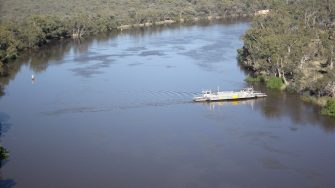
Date: Wednesday, November 2, 2016
Project: Eastern Australian Waterbird Survey
Observer: Richard Kingsford
Today was a great day for ‘water sights’. Low wind and a cool day were ideal conditions for flying, starting with where the glassy blue River Murray joined the Darling River from the north at Wentworth. Rippling water and the drowned Lock 10 at Wentworth showed a river in flood. The locks down the river are designed to allow boats to move between quite different levels of the river but not today – all the locks could hardly be seen.
Surveying the River Murray where it joins the Darling River
Lock 10 ‘drowned out’ by the flood in the River Murray
In various places, the river had broken its banks, creeping across the floodplain and creating habitats as it went, for colonising plants and animals. Down river a bit, Frenchmans Creek is leveed off to make sure that water held in Lake Victoria, which acts like a big dam, can be sent downstream for the river, Adelaide, towns and irrigation. Not many people know but the River Murray is managed like a giant plumbing system, starting up in the Great Dividing Range with Dartmouth and Hume Dams, down the River Murray, including the Menindee Lakes, near Broken Hill, and Lake Victoria. Water can be released from any of the dams or storages in this giant system.
Lake Victoria is used to store water for downstream uses
As we continued downstream, there was more and more evidence that the water had moved out onto the floodplain. This is when things really happen on rivers – biologically. The floodplains are ‘production houses’ of rivers. The first to fill are the many horseshoe-shaped billabongs, common along this part of the river.
Horseshoe billabong along the River Murray
Governments have increasingly invested on getting the water out on to the floodplains more frequently because diversions of flows upstream has reduced natural frequencies of flooding. This has sometimes required engineering works on the floodplain, which allows environmental water to move onto the floodplain.
Ferry crossing the River Murray
There were many different billabongs and lakes which rely on water from the River Murray, at different stages of flooding. They varied enormously in their water chemistry. Some had just flooded and so were brown, thick with clay particles. There was one which was obviously slightly salty, clearing the water, allowing vegetation (aquatic macrophytes) to grow on the bottom. No surprise – this was also a great attractant to swans.
Aquatic vegetation growing on the floor of a salt lake
As we progressed further down the river, there were the odd small colonies of white ibis but also straw-necked ibis of not more than a hundred.
Colony of ibis on one of the lakes supplied by the River Murray
We finished our survey after Lock 3. Beyond this, the River Murray became more confined to its main channel and was increasingly flanked by high cliffs.
High cliffs flank the main channel of the Lower River Murray
After this, we did our first survey of the most impressive wetland system in the entire Murray-Darling Basin – the Coorong and the Lower Lakes. This afternoon, we surveyed Lake Alexandrina and Lake Albert. This year the water had flooded into areas that we hadn’t seen before. As always, there were lots of birds but not as many as usual. Cormorants, pelicans and swans dominated. Notable absences were the shelduck, terns, grey teal and even black duck. Like everywhere – they were spread thinly.
Surveying Lake Alexandrina
By 1940, river flows were decreasing to this system so much that barrages were built to separate the freshwater system from the salt system. They now have quite different water chemistry. The waterbird communities are also different with more terns and migratory shorebirds on the more salty part which is the Coorong.
Surveying along the barrages, separating Lake Alexandrina from the Coorong
While the waterbird diversity and numbers were down, like most other places. There were some impressive colonies of breeding waterbirds, including ibis and cormorants.
Surveying the large colony of pied and great cormorants on Lake Alexandrina
Cormorant colony on Lake Alexandrina
Colony of straw-necked ibis on Lake Alexandrina
Large flock of feeding cormorants and pelicans
Tomorrow – we will find out what’s happening on the Coorong and also do our second count of the two freshwater lakes.
